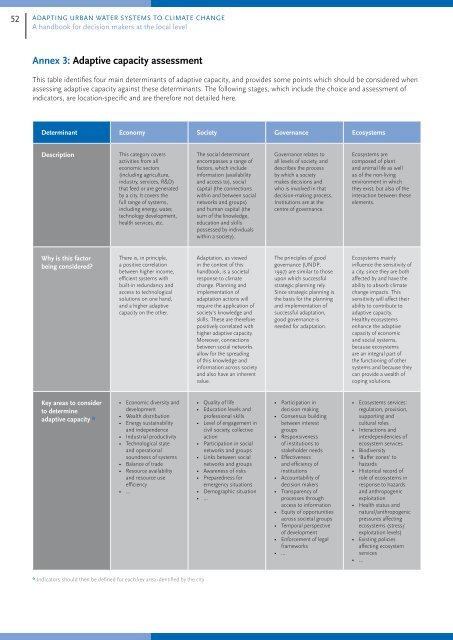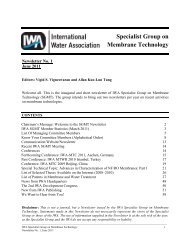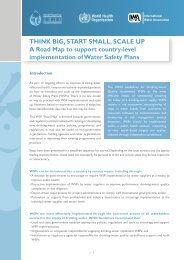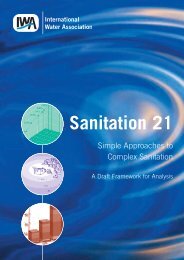AdApting urbAn wAter systems to climAte chAnge - IWA
AdApting urbAn wAter systems to climAte chAnge - IWA
AdApting urbAn wAter systems to climAte chAnge - IWA
Create successful ePaper yourself
Turn your PDF publications into a flip-book with our unique Google optimized e-Paper software.
52 Adapting urban water <strong>systems</strong> <strong>to</strong> climate change<br />
A handbook for decision makers at the local level<br />
Annexes<br />
53<br />
Annex 3: Adaptive capacity assessment<br />
This table identifies four main determinants of adaptive capacity, and provides some points which should be considered when<br />
assessing adaptive capacity against these determinants. The following stages, which include the choice and assessment of<br />
indica<strong>to</strong>rs, are location-specific and are therefore not detailed here.<br />
Annex 4: Co-benefits of sustainable water management options<br />
Options Urban water management benefits Selected quality of life benefits and co-benefits <strong>to</strong> other urban management sec<strong>to</strong>rs<br />
Alternative<br />
supplies for nonpotable<br />
demand<br />
• Water supply: Reduces demand<br />
• Water supply: Reduces treatment and pumping costs<br />
• Eco<strong>systems</strong>: Less water needs <strong>to</strong> be abstracted from the environment<br />
• Urban economic activities: Increased water availability for other purposes<br />
• Agriculture and urban green areas: Provides a cheap source of irrigation water<br />
Determinant Economy Society Governance Eco<strong>systems</strong><br />
Metering and<br />
tariffs<br />
• Water supply: Reduces demand<br />
• Water supply: Reduces treatment and pumping costs<br />
• Eco<strong>systems</strong>: Less water needs <strong>to</strong> be abstracted from the environment<br />
• Quality of life (social equity): Variable tariffs ensure low-cost fulfilment of basic water needs for<br />
low-income groups<br />
Description<br />
Why is this fac<strong>to</strong>r<br />
being considered<br />
This category covers<br />
activities from all<br />
economic sec<strong>to</strong>rs<br />
(including agriculture,<br />
industry, services, R&D)<br />
that feed or are generated<br />
by a city. It covers the<br />
full range of <strong>systems</strong>,<br />
including energy, water,<br />
technology development,<br />
health services, etc.<br />
There is, in principle,<br />
a positive correlation<br />
between higher income,<br />
efficient <strong>systems</strong> with<br />
built-in redundancy and<br />
access <strong>to</strong> technological<br />
solutions on one hand,<br />
and a higher adaptive<br />
capacity on the other.<br />
The social determinant<br />
encompasses a range of<br />
fac<strong>to</strong>rs, which include<br />
information (availability<br />
and access <strong>to</strong>), social<br />
capital (the connections<br />
within and between social<br />
networks and groups)<br />
and human capital (the<br />
sum of the knowledge,<br />
education and skills<br />
possessed by individuals<br />
within a society).<br />
Adaptation, as viewed<br />
in the context of this<br />
handbook, is a societal<br />
response <strong>to</strong> climate<br />
change. Planning and<br />
implementation of<br />
adaptation actions will<br />
require the application of<br />
society’s knowledge and<br />
skills. These are therefore<br />
positively correlated with<br />
higher adaptive capacity.<br />
Moreover, connections<br />
between social networks<br />
allow for the spreading<br />
of this knowledge and<br />
information across society<br />
and also have an inherent<br />
value.<br />
Governance relates <strong>to</strong><br />
all levels of society, and<br />
describes the process<br />
by which a society<br />
makes decisions and<br />
who is involved in that<br />
decision-making process.<br />
Institutions are at the<br />
centre of governance.<br />
The principles of good<br />
governance (UNDP,<br />
1997) are similar <strong>to</strong> those<br />
upon which successful<br />
strategic planning rely.<br />
Since strategic planning is<br />
the basis for the planning<br />
and implementation of<br />
successful adaptation,<br />
good governance is<br />
needed for adaptation.<br />
Eco<strong>systems</strong> are<br />
composed of plant<br />
and animal life as well<br />
as of the non-living<br />
environment in which<br />
they exist, but also of the<br />
interaction between these<br />
elements.<br />
Eco<strong>systems</strong> mainly<br />
influence the sensitivity of<br />
a city, since they are both<br />
affected by and have the<br />
ability <strong>to</strong> absorb climate<br />
change impacts. This<br />
sensitivity will affect their<br />
ability <strong>to</strong> contribute <strong>to</strong><br />
adaptive capacity.<br />
Healthy eco<strong>systems</strong><br />
enhance the adaptive<br />
capacity of economic<br />
and social <strong>systems</strong>,<br />
because eco<strong>systems</strong><br />
are an integral part of<br />
the functioning of other<br />
<strong>systems</strong> and because they<br />
can provide a wealth of<br />
coping solutions.<br />
Behaviour<br />
change<br />
Water efficiency<br />
measures<br />
Leakage<br />
management<br />
Aquifer S<strong>to</strong>rage<br />
and Recovery<br />
Urine diversion<br />
<strong>to</strong>ilets<br />
Soil Aquifer<br />
Treatment<br />
Constructed<br />
wetlands<br />
Waste<br />
Stabilisation<br />
Ponds<br />
Biogas<br />
production from<br />
sludge<br />
• Water supply: Reduces demand<br />
• Water supply: Reduces treatment and pumping costs<br />
• Water supply: Reduces demand<br />
• Water supply: Reduces treatment and pumping costs<br />
• Water supply: Reduces demand<br />
• Water supply: Reduces treatment and pumping costs<br />
• Water supply: Increases s<strong>to</strong>rage capacity<br />
• Water supply: Protects water quality<br />
• S<strong>to</strong>rmwater management: Runoff reduction<br />
• Wastewater treatment: Contaminant removal<br />
• Wastewater treatment: Reduces costs<br />
• S<strong>to</strong>rmwater management: Peak runoff reduction<br />
• Wastewater treatment: Reduces costs<br />
• Wastewater treatment: Reduces costs<br />
• S<strong>to</strong>rmwater management: Reduces runoff<br />
• Water supply: Reduces potable water demand<br />
• Wastewater treatment: Reduces costs<br />
• Water supply: Reduces demand for potable water<br />
• Wastewater treatment: Reduces costs<br />
• Eco<strong>systems</strong>: Less water needs <strong>to</strong> be abstracted from the environment<br />
• Urban economic activities: Increased water availability for other purposes<br />
• Energy: Reduced energy consumption through the use of less hot water<br />
• Eco<strong>systems</strong>: Less water needs <strong>to</strong> be abstracted from the environment<br />
• Energy: Reduced energy consumption through the use of less hot water<br />
• Urban economic activities: Increased water availability for other purposes<br />
• Eco<strong>systems</strong>: Less water needs <strong>to</strong> be abstracted from the environment<br />
• Quality of life (noise and disruption): Future repairs are avoided by pipe replacement<br />
• Quality of life (health): Reduces risks of contaminants entering pipes<br />
• Urban economic activities: Provides a more reliable supply of water<br />
• Quality of life (health): ASR provides natural protection from organic pollution and<br />
contaminated s<strong>to</strong>rmwater runoff<br />
• Eco<strong>systems</strong>: Subsurface baseflows from ASR can be used <strong>to</strong> support natural eco<strong>systems</strong><br />
• Agriculture and urban green areas: Provides a cheap source of irrigation water<br />
• Agriculture and urban green areas: Provides a cheap fertiliser, and increases urban food security<br />
• Eco<strong>systems</strong>: Reduction of the nutrient load from wastewater effluent<br />
• Agriculture and urban green areas: Provides a cheap source of irrigation water<br />
• Quality of life (aesthetic enjoyment and amenity value): Increase in urban green space<br />
• Urban development: On-site treatment of greywater and s<strong>to</strong>rmwater<br />
• Eco<strong>systems</strong>: Creation of urban eco<strong>systems</strong><br />
• Agriculture and urban green areas: Provides a cheap source of irrigation water<br />
• Quality of life (disposable income): Source of local income through harvesting of fish and plants<br />
• Agriculture: Provides a cheap fertiliser<br />
• Quality of life (increased disposable income): Reduces cooking and heating bills<br />
• Urban economic activities: Provides a cheap and renewable energy source<br />
Key areas <strong>to</strong> consider<br />
<strong>to</strong> determine<br />
adaptive capacity *<br />
• Economic diversity and<br />
development<br />
• Wealth distribution<br />
• Energy sustainability<br />
and independence<br />
• Industrial productivity<br />
• Technological state<br />
and operational<br />
soundness of <strong>systems</strong><br />
• Balance of trade<br />
• Resource availability<br />
and resource use<br />
efficiency<br />
• …<br />
• Quality of life<br />
• Education levels and<br />
professional skills<br />
• Level of engagement in<br />
civil society, collective<br />
action<br />
• Participation in social<br />
networks and groups<br />
• Links between social<br />
networks and groups<br />
• Awareness of risks<br />
• Preparedness for<br />
emergency situations<br />
• Demographic situation<br />
• …<br />
• Participation in<br />
decision making<br />
• Consensus building<br />
between interest<br />
groups<br />
• Responsiveness<br />
of institutions <strong>to</strong><br />
stakeholder needs<br />
• Effectiveness<br />
and efficiency of<br />
institutions<br />
• Accountability of<br />
decision makers<br />
• Transparency of<br />
processes through<br />
access <strong>to</strong> information<br />
• Equity of opportunities<br />
across societal groups<br />
• Temporal perspective<br />
of development<br />
• Enforcement of legal<br />
frameworks<br />
• …<br />
• Eco<strong>systems</strong> services:<br />
regulation, provision,<br />
supporting and<br />
cultural roles<br />
• Interactions and<br />
interdependencies of<br />
ecosystem services<br />
• Biodiversity<br />
• ‘Buffer zones’ <strong>to</strong><br />
hazards<br />
• His<strong>to</strong>rical record of<br />
role of eco<strong>systems</strong> in<br />
response <strong>to</strong> hazards<br />
and anthropogenic<br />
exploitation<br />
• Health status and<br />
natural/anthropogenic<br />
pressures affecting<br />
eco<strong>systems</strong> (stress/<br />
exploitation levels)<br />
• Existing policies<br />
affecting ecosystem<br />
services<br />
• …<br />
Sludge reuse<br />
Greywater reuse<br />
Site planning<br />
Porous paving,<br />
swales, etc…<br />
Rainwater<br />
harvesting<br />
Green roofs<br />
• Wastewater treatment: Reduces costs<br />
• S<strong>to</strong>rmwater management: Improves soil moisture<br />
retention<br />
• Water supply: Reduces demand for potable water<br />
• Wastewater treatment: Reduces costs<br />
• S<strong>to</strong>rmwater management: Reduced runoff<br />
• Wastewater treatment: Pollutants are contained at<br />
the source and nonpoint pollution is managed<br />
• S<strong>to</strong>rmwater management: Reduced runoff<br />
• Water supply: Recharge of underlying aquifers<br />
• Wastewater treatment: Pollutant removal<br />
• S<strong>to</strong>rmwater management: Reduced runoff<br />
• Water supply: Reduces demand for potable water<br />
• S<strong>to</strong>rmwater management: Reduced runoff<br />
• Water supply: Can reduce demand for potable water<br />
• Wastewater treatment: Removal of airborne<br />
pollutants from runoff<br />
• Eco<strong>systems</strong>: Source of nutrients<br />
• Agriculture and urban green areas: Provides a cheap fertiliser and soil conditioner<br />
• Urban economic activities: Provides a cheap and renewable energy or fuel source<br />
• Eco<strong>systems</strong>: Creation of urban eco<strong>systems</strong><br />
• Agriculture and urban green areas: Provides a cheap source of irrigation water<br />
• Quality of life (aesthetic enjoyment and amenity value): Increase in urban green space<br />
• Eco<strong>systems</strong>: Protection and enhancement of local habitats<br />
• Urban development: Development of land can be implemented cost-effectively<br />
• Quality of life (aesthetic enjoyment): S<strong>to</strong>rmwater-sensitive landscaping emphasises aesthetic<br />
features<br />
• Urban economic activities: Reduced flooding risk<br />
• Quality of life (aesthetic enjoyment and amenity value): Swales provide grassy areas<br />
• Eco<strong>systems</strong>: Less water needs <strong>to</strong> be abstracted from the environment<br />
• Urban economic activities: Provides a more reliable supply of water<br />
• Agriculture and urban green areas: Provides a cheap source of irrigation water<br />
• Quality of life (general): Reduces water bills and provides a more secure supply of water<br />
• Eco<strong>systems</strong>: Creation of urban eco<strong>systems</strong><br />
• Quality of life (health): Improves air quality and reduces the urban heat island effect<br />
• Quality of life (aesthetic enjoyment and amenity value): Increase in urban green space<br />
• Energy: Reduced energy consumption through the use of less heating and air conditioning<br />
* Indica<strong>to</strong>rs should then be defined for each key area identified by the city<br />
Detention ponds<br />
and basins<br />
• S<strong>to</strong>rmwater management: Reduced runoff<br />
• Wastewater treatment: Pollutant removal<br />
• Quality of life (aesthetic enjoyment and amenity value): Increase in urban green space. Use as<br />
playgrounds or sports facilities possibly during dry weather<br />
• Urban economic activities: Encourages investment in urban areas that would otherwise be prone<br />
<strong>to</strong> flooding<br />
Source: Modules 3, 4 and 5 of the SWITCH Training Kit (ICLEI European Secretariat, 2011)
















